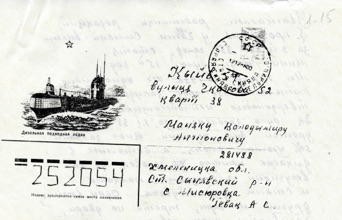












Full Name in Ukrainian: А. C. Гевак
Full Name in English: A. Hevak
Data of Birth: Circa 1917-1918
Place of Birth: Mysiurivka
Raion: Stara Syniava raion (currently Khmelnytsky raion)
Oblast: Vinnytsia oblast (currently Khmelnytsky oblast)
Country: Ukraine
Copy of original: Yes
Envelope: Yes
Number of pages: 2
Keywords: Ukraine--History--Famine, 1932-1933--Personal narratives; Famines--Ukraine--History--Sources; Famine victims; Holodomor; Голодомор; search brigades; perpetrators; activists; survival strategies; child labor; persecution; grain requisitioning
Notes: Abridged letter is published in 33: holod. Narodna Knyha-Memorial book, Kyiv: Radiansky pysmennyk, 1991, p. 140.


A. Hevak was 15 at the time of the Holodomor. He describes events in the village of Mysiurivka in Stara Syniava raion, Vinnytsia oblast (currently Mysiurivka, Khmelnytsky raion, Khmenlnytsky oblast).
In 1930, Hevak’s father was convicted and given a three-year prison term as a “persistent non-payer.” In 1932, Hevak’s family remained individual farmers (odnoosibnyky). The family had a good harvest and half of it was collected from them “from the field”. The rest of the harvest was expropriated from them by the search brigade in December of 1932.
In charge of the search brigade of nearly 20 activists was a commissar (upovnovazheny) “from the raion” with the last name Mykhalchuk. The search brigade, also known as “black broom,” took not only grain, but also livestock and even wooden spoons. In other words, the search brigade left nothing behind.
In 1933, Hevak worked as a cow shepherd in exchange for food. His mother, sister and little brother survived “on potatoes.” Their grandfather did not survive. In spring, people started to swell and die. They were buried without proper burial rites and mostly without coffins.
SYNOPSIS


The UCRDC depends on voluntary donations – both individual and institutional - for its financing.
It provides receipts for tax purposes.
-
‣Home



